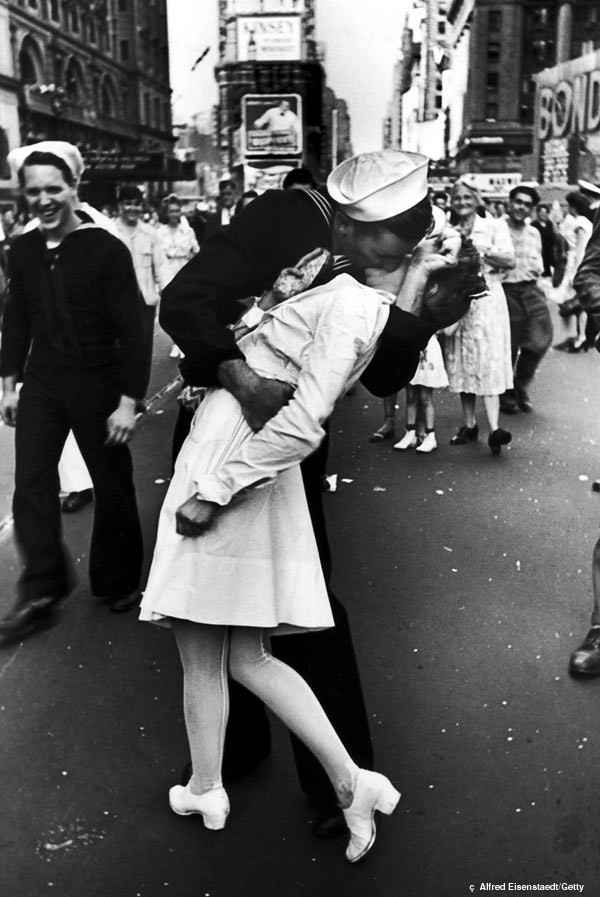In the Blog
Second Looks: A Sailor, A Nurse, and Sexual Assault
Photos are funny, aren’t they? A look through an album or Instagram and you see moments in time, frozen with the click of a shutter. It is, as Susan Sontag observed in her book of essays On Photography, proof that you were somewhere. A photo is a pictorial declaration that you took up space, at some point, in some location.
And then, there are those images that are, for many, instantly recognizable. We might know nothing of the subjects but we know the image. Devoid of context, this particular mix of shapes and shades is familiar. It’s a strange rupture to navigate. Like this image, for instance.

Taken on August 14, 1945 by LIFE magazine photographer Alfred Eisenstaedt, we see, at first glance, a sailor, a woman, a kiss and what looks to be parade. It’s a celebration. World War II is over.
But there’s more to this story. The recent publication of a book based on this image has put this photo’s subjects in the spotlight once more. Their names are Greta Zimmer Friedman and George Mendonsa. At the time this image was captured, Friedman was working as a nurse and was on a break. Mendonsa was a sailor. They were not a couple and had not met prior to “the kiss.”
In fact, there was nothing romantic about this kiss. This was sexual assault. Mendonsa was drunk and grabbed Friedman. Friedman never consented to being kissed. Eisenstaedt happened to be walking by, and over the course of 10 seconds, snapped several pictures.
Recent quotes offered by Friedman corroborate this.
- “It wasn’t my choice to be kissed. The guy just came over and grabbed!” - “I did not see him approaching, and before I knew it, I was in this vice grip. [sic]” - “You don’t forget this guy grabbing you.” - “That man was very strong. I wasn’t kissing him. He was kissing me.”
Placed in context, this image provides us with other narratives that reveal uncomfortable truths surrounding systemic oppression and structural violence. There are narratives of sexism, of subjects and objects, and of heteronormativity. When critically analysed based on political events at that particular historical moment in 1945, the Marshall Plan – economic imperialism on a massive scale – was about to be introduced, marking the start of a series of disastrous, structurally violent foreign aid programs in the global south.
Certain responses have attempted to argue that it’s unfair to apply contemporary standards to 1945. Not only is this faulty logic, but watch this interview. The narrative revolves around George Mendonsa. I’ve yet to read an article focusing on Mendosa that interrogates how truly problematic this absence of consent is, or at the very least ask a question like “Why would you kiss someone who did not consent to be kissed?”
Other reactions to these critiques fall back on, “He didn’t mean anything by it.” But that’s the point, isn’t it? Did the voyeur staring at me early one morning as I got out of the shower mean anything by it? Few perpetrators set out to assault their victims. That’s what makes rape culture so insidious. The onus rests on the victim to confront their oppressor or shrug it off, and wonder what they could have done differently to prevent the incident. Until there is a collective admission that “nice guys” are capable of sexual assault, rape culture will remain intact.
Sontag writes that “To photograph people is to violate them, by seeing them as they never see themselves, by having knowledge of them that they can never have; it turns people into objects that can be symbolically possessed.”
Beyond photography’s violation of unwilling subjects is a complicity in viewership, as well. This photo persists as a symbolic possession through collective repetition. Its ubiquity belies its unsettling context, and so this photo remains a fixture at poster sales across campuses. We see Greta Zimmer Friedman as she never was nor claimed to be: taking part in a consensual embrace, a joyful lover ready to start her life with her partner. This myth has been so durable because of a collective investment to make it so, Friedman’s lived experience be damned.
The unwillingness to acknowledge this violation and take seriously Friedman’s account reveals how entrenched rape culture is. Sexual assault is not only prevalent, but we live in a culture that dismisses and diminishes the experiences of survivors. This is violent.
We live in a culture that is more devoted to reproducing a myth about a black-and-white photo than it is to encouraging enthusiastic, mutual consent and actively dismantling rape culture. And this makes me angry.
Further reading: The Kissing Sailor or “The Selective Blindness of Rape Culture” from Crates and Ribbons: In pursuit of gender equality
The Kissing Sailor, Part 2 - Debunking Misconceptions from Crates and Ribbons: In pursuit of gender equality



